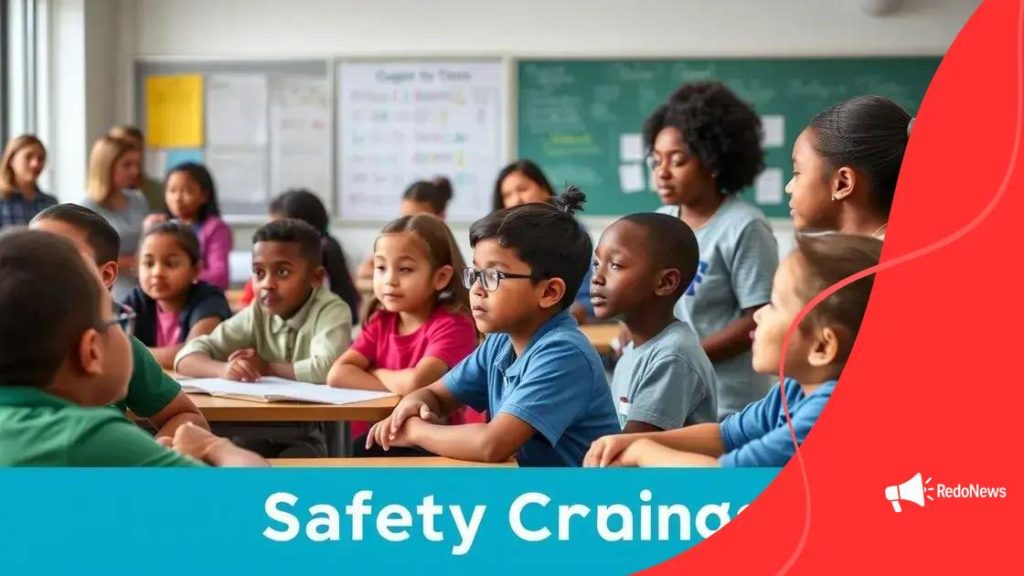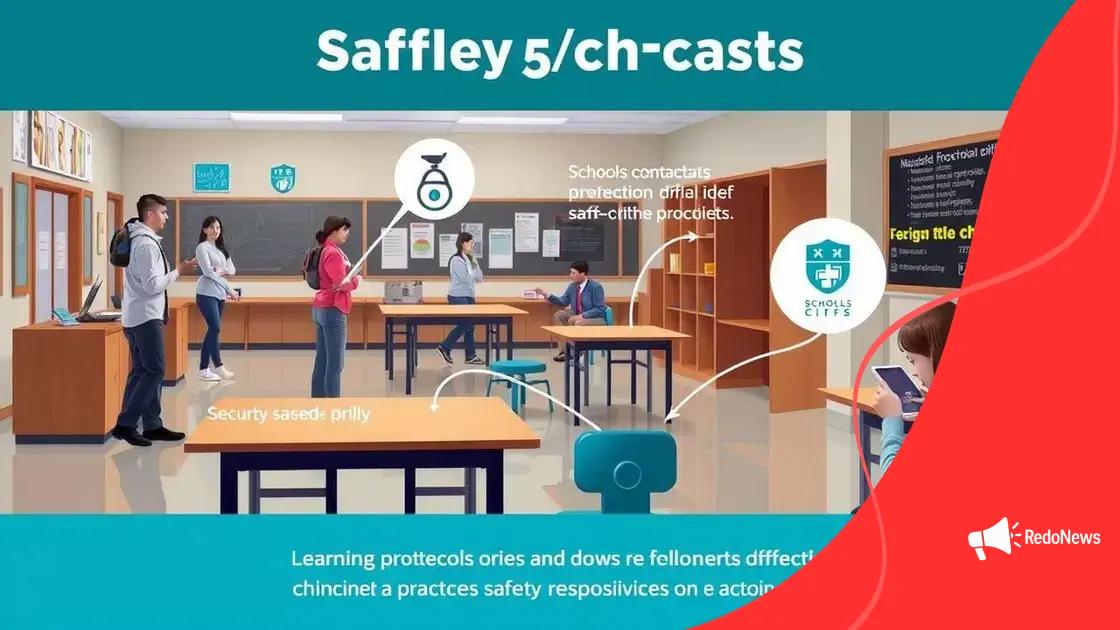School safety: Concerns high and solutions within reach

School safety concerns today involve physical threats, mental health issues, and the need for effective community collaboration to implement innovative strategies and enhance security measures.
School safety: Concerns high has become a pressing issue that affects students, parents, and educators alike. With various threats emerging, it’s essential to explore effective measures that can enhance safety in schools.
Understanding the current landscape of school safety
Understanding the current landscape of school safety is crucial for students, parents, and educators. Schools are evolving places, often facing new challenges that impact the safety of children. As we delve deeper, it’s important to look at what makes schools secure and what issues are currently pressing.
Key Factors Influencing School Safety
Several factors contribute to the overall safety of schools today. These include physical security measures, mental health initiatives, and community involvement.
- Physical security measures include surveillance cameras and secure entry points.
- Mental health initiatives focus on providing support services for students.
- Community involvement fosters collaboration between parents, teachers, and local law enforcement.
Additionally, schools must adapt to the reality of violent incidents affecting campuses. The increasing concern over school shootings has prompted a reevaluation of existing protocols. With the focus on prevention, schools are investing in training programs for staff and students.
Monitoring and Reporting
Another critical aspect of school safety is monitoring and reporting mechanisms. Many schools are implementing anonymous reporting systems. These systems allow students to report threats or suspicious behavior without fear. This proactive approach not only helps prevent potential incidents but also creates a safer environment for all.
As we look at the broader picture, the integration of technology is also reshaping school safety. For instance, data analytics are being used to identify patterns in behavior and address them before they escalate. By understanding these trends, schools can tailor their safety protocols effectively.
Common safety concerns faced by schools today
Common safety concerns faced by schools today include a range of issues that affect both students and staff. With the ever-changing environment in schools, understanding these concerns is vital for ensuring a safe learning atmosphere.
Types of Safety Concerns
Many safety concerns arise from various factors. These can be categorized into physical safety, emotional safety, and health-related issues.
- Physical safety involves threats like bullying and violence.
- Emotional safety includes mental health challenges among students.
- Health-related issues focus on the spread of illnesses, like flu or COVID-19.
Another pressing issue is the presence of weapons in schools. Incidents involving firearms or other weapons can occur, making this a primary concern for parents and educators. Additionally, natural disasters represent another layer of risk that schools must prepare for. From tornadoes to earthquakes, having contingency plans is crucial.
The Impact of Technology
With the rise of technology, cyberbullying has emerged as a significant threat. Students are increasingly subjected to online harassment, which can affect their mental health. Furthermore, social media can contribute to spreading harmful rumors and misinformation. It’s essential for schools to educate students about responsible internet use.
In addition, the lack of adequate supervision and support staff can exacerbate these issues. When resources are limited, addressing safety concerns becomes even more challenging. Schools need to prioritize hiring trained professionals, such as counselors and security personnel, to create a safe environment.
Effective strategies for improving school safety

Effective strategies for improving school safety are essential for creating an environment where students can learn without fear. Schools today face numerous challenges, but several proven methods can enhance safety measures.
Implementing Safety Protocols
Establishing clear safety protocols is one of the first steps schools can take. Regular drills for fire, lockdown, and evacuation help prepare students and staff for emergencies. Training teachers and staff on how to respond to various situations also builds confidence in managing potential risks.
- Conduct regular safety drills.
- Train staff on emergency response.
- Develop a comprehensive emergency plan.
In addition to drills, enhancing communication within the school is crucial. Open lines of communication encourage students to report concerns and foster a sense of community. Inviting parents into discussions about safety can also strengthen the support system.
Utilizing Technology
Advancements in technology are also transforming school safety. Many schools are adopting security cameras and access control systems to monitor activities. These tools not only deter potential misconduct but also provide security footage that can be crucial during incidents.
Furthermore, utilizing apps for anonymous reporting allows students to voice their concerns without fear. These technologies can improve response times and ensure that potential threats are addressed quickly.
Collaboration with local law enforcement enhances the security framework. They can offer insights on safety practices and assist in conducting safety assessments. Engaging with community resources creates a network that supports schools in their safety efforts.
The role of parents and community in school safety
The role of parents and community in school safety is vital. When parents, community members, and schools work together, they create a safer environment for children to learn and grow.
Building Strong Partnerships
Establishing partnerships between schools and parents can lead to effective safety measures. Parents should be involved in developing safety policies and participate in discussions about school safety plans. Regular meetings and workshops can spark these valuable collaborations, helping parents understand what schools are doing to keep children safe.
- Encourage parents to attend school safety meetings.
- Share safety updates through newsletters or emails.
- Conduct workshops on safety awareness for parents and students.
Additionally, schools can engage the community by inviting local organizations and law enforcement to participate in safety initiatives. This not only provides resources but also builds trust and accountability among all stakeholders involved.
Creating a Supportive Environment
Community involvement extends beyond just policies. It also includes fostering an environment where students feel safe reporting issues. Parents can help by encouraging their children to speak up about bullying or other safety concerns. Open lines of communication between children, parents, and teachers help in addressing issues before they escalate.
Moreover, community events like safety fairs or forums create opportunities for deeper engagement. In these settings, families can learn more about school safety practices and ways they can contribute. Making safety a community-wide effort not only empowers parents but also reinforces the message that everyone has a role in keeping schools safe.
Navigating the future of school safety initiatives
Navigating the future of school safety initiatives is essential for ensuring that schools remain secure environments for learning. As challenges continue to evolve, adapting safety measures will be crucial. Schools must embrace innovative strategies to stay ahead of potential threats.
Emerging Technologies
One key aspect of enhancing school safety is leveraging emerging technologies. Many schools are adopting advanced security systems, such as biometric scanners and AI-powered surveillance cameras. These technologies not only improve monitoring but also facilitate quicker responses to incidents.
- Integration of AI for threat detection.
- Use of data analytics to identify safety trends.
- Implementation of mobile apps for safety reporting.
Furthermore, virtual reality (VR) training programs are becoming popular for preparing staff and students for crisis situations. These immersive experiences allow individuals to practice their responses in a controlled setting, boosting confidence and readiness.
Community Collaboration
Collaboration with local organizations and law enforcement is another crucial strategy. Schools can enhance their safety initiatives by partnering with community groups to conduct safety workshops and awareness campaigns. Such collaborations ensure that safety measures are culturally relevant and effective.
Involving parents in the planning and execution of safety initiatives fosters a community mindset. When parents feel engaged, they are more likely to support school safety policies and contribute ideas based on their experiences and insights.
Additionally, adapting to new policies and standards from government agencies will be important for school leaders. Staying informed about legislative changes can help schools comply with safety regulations and access funding for safety improvements.
FAQ – Frequently Asked Questions about School Safety
What are the main strategies to improve school safety?
Main strategies include implementing safety protocols, utilizing technology, and fostering community collaboration.
How can parents contribute to school safety?
Parents can participate in safety meetings, support safety initiatives, and encourage open communication with their children about safety concerns.
What role does technology play in school safety?
Technology enhances monitoring through security systems, allows for quick incident reporting, and provides training tools for emergencies.
Why is community involvement important for school safety?
Community involvement builds a support network that promotes trust, shares resources, and fosters a sense of responsibility for student safety.
